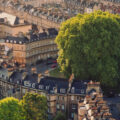It was a poet who wrote one of the first guidebooks on the Lake District. That itself speaks volumes about the beauty of this UNESCO World Heritage Site located in England’s northwest county of Cumbria.
Inspired by its breathtaking landscape, William Wordsworth, apart from penning some of his most famous poems while staying in the region, authored a guidebook on the Lake District way back in 1820, sparking a wave of tourist activity that hasn’t halted since.
It is also not surprising that the Lake District has played muse for many before and after him. Anyone who visits this region is immediately awestruck by its romantic setting. The allure of the area, though, is hidden in the name itself. With around 16 lakes dotting the countryside, the Lake District is also the largest National Park in England.

Note: This post contains Amazon affiliate links. If you use these to buy any products, you get it for no extra cost, while I get a small commission from Amazon in return. Thank you.
While Wordsworth romanticized the idea of uncovering the splendor of the craggy fells (local name for small peaks) and glassy lakes, Alfred Wainwright went a step further, quite literally.
After spending a short vacation in the Lake District, he chose to move here permanently. Taking up a work assignment, he spent his free time plotting routes traversing these Cumbrian fells. His compilation from 1952, ‘Pictorial Guides to the Lakeland Fells’ published as seven volumes continue to enthuse walkers even today.

Given its nomenclature, it isn’t hard to comprehend why the Lake District is one of the most popular tourist destinations in the UK. The lake vistas are quite spectacular and reason enough to plan a trip to this beautiful part of the world.
While some lakes are easily accessible, most require short walks that lead to picture-postcard views. Hiking is, after all, one of the main things to do in the Lake District. Tarn Hows from Coniston, Orrest Head from Windermere, and Latrigg from Keswick are perfect for rambling, though peppered with some gradual ascents. For experienced hikers, there are a plethora of walks, including one up Scafell Pike, the highest peak in England.

Villiage hopping across the region is another favorite thing to do in the Lake District. However, you will find that most of what the area has to offer is centered near the towns of Keswick, Ambleside, and Bowness-on-Windermere. Hugging the shores of Lake Windermere, these form a perfect base to head deeper into the countryside.
Although The Lake District in the UK sees a lot of tourists, it isn’t hard to find solitude given its vastness. Venture a little off the tourist trail, and you will discover remote locations that are forbiddingly beautiful.
An untouched gem in the Duddon Valley is the Ulpha Bridge that serves as a picture-perfect backdrop in the National Park. It is the starting point for many stunning hikes and on a balmy summer day, perfect for sunbathing along the river. The Derwent Water is another hauntingly beautiful spot with a large lake and small-uninhabited islands in it. Pick an island and a canoe for a day out to an almost private picnic spot. Amongst the many attractions in the Lake District, this is by far the most romantic and intimate.
But it’s not all about nature in the Lake District. Here you will find stone circles dating back to Neolithic times, remains of the Roman Empire, and ruins of abbeys, churches, and castles. Given its location on the boundary between England and Scotland, it has seen a fair bit of unrest during medieval times. Thus, the landscape is interspersed with many ruins.

Castlerigg, apart from boasting a history going back about 3000BC to the Neolithic times, also offers one of the most dramatic locations of stone circles in the country. The remains of the Roman Fort dating back to 2nd century AD at Ambleside further make for an exciting visit.
For more recent and comparatively well-preserved history, a drive up the steep, narrow road to Shap Abbey, founded in the 12th century, is well worth your time. In the Western Lakes area, the Muncaster Castle is a well-preserved historic house built around the 13th century but believed to be standing on Roman ruins dating back to 79 AD! Today it is a repository of medieval artifacts and impressive Victorian gardens.
Unknown to many, the Lake District also has an industrial history. The 300-year old Honister Slate Mine is one place that uses a mix of traditional and modern processes to extract and produce slate that adorns the roofs of many homes. The tours here take you through the current working of the mines.

While it’s easy to get lost in the history and topography of the Lake District, one cannot resist the lure of its literary connection. The Dove Cottage nestled near the village of Grasmere entices you to walk in Wordsworth’s footsteps, giving glimpses of his life spent here between 1799 and 1808. The quirky museum next door is packed with the famous poet’s manuscripts and memorabilia, making it a must-visit destination in the Lake District for book lovers.
Near Sawrey’s village is where Beatrix Potter lived and penned many of her children’s classics, including the tales of Peter Rabbit. Her 17th century home with a slate roof, called the Hill Top, is furnished with original furniture, framed paintings, crockery, and a rocking chair. The most fun is had seeing scenes illustrated in her books come alive in and around the home.

All that touring can be tiring, but the Lake District has a remedy for that as well. Numerous atmospheric inns and charming pubs dotted around its villages make for a perfect sanctuary at the end of a long day. If you choose more secluded villages, it isn’t difficult to find a cozy private corner with spectacular panoramas.
The one attraction in the Lake District that many make a beeline for is a slice of gingerbread at Grasmere Gingerbread. Made with an original recipe of the Victorian cook Sarah Nelson, it is a sweet cross between a biscuit and a cake with a spicy tinge. This bakery is located in the village of Grasmere, from which it derives its legendary name.
In the end, anywhere you look, a quintessentially English experience awaits you in the Lake District.
Photos: Pixabay






1 Comment
theyearwithoutwimbledon
I usually stay in Grasmere, because it’s cheaper than Windermere, and I make for the gingerbread shop as soon as I arrive!